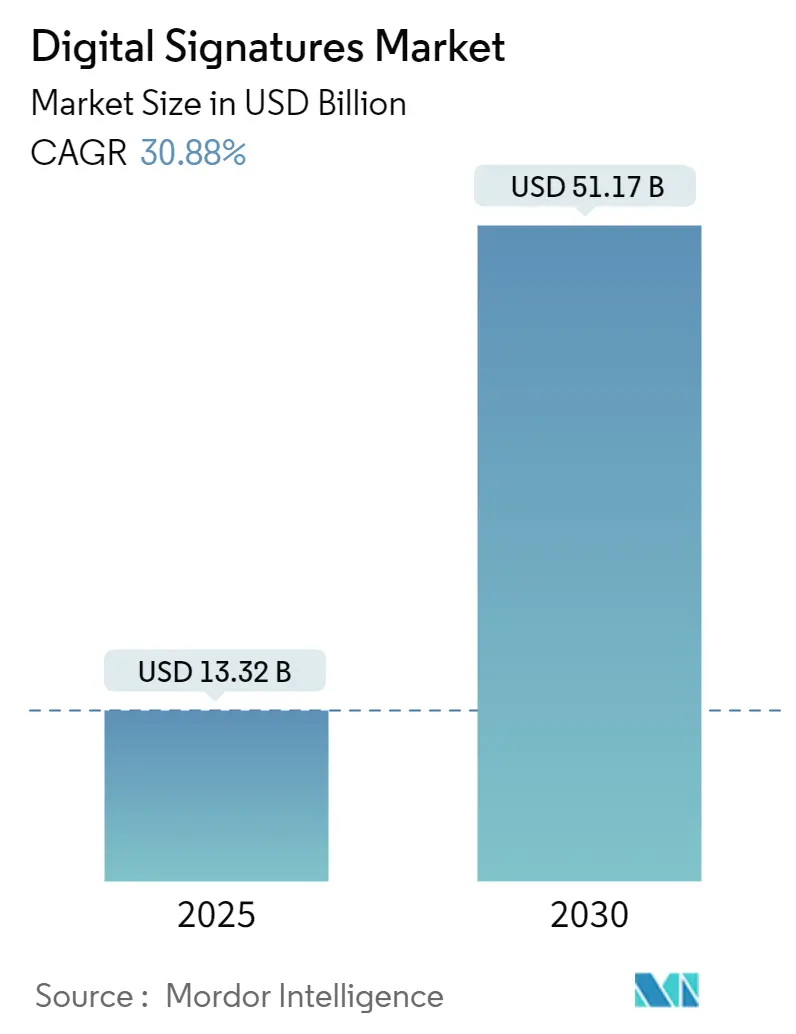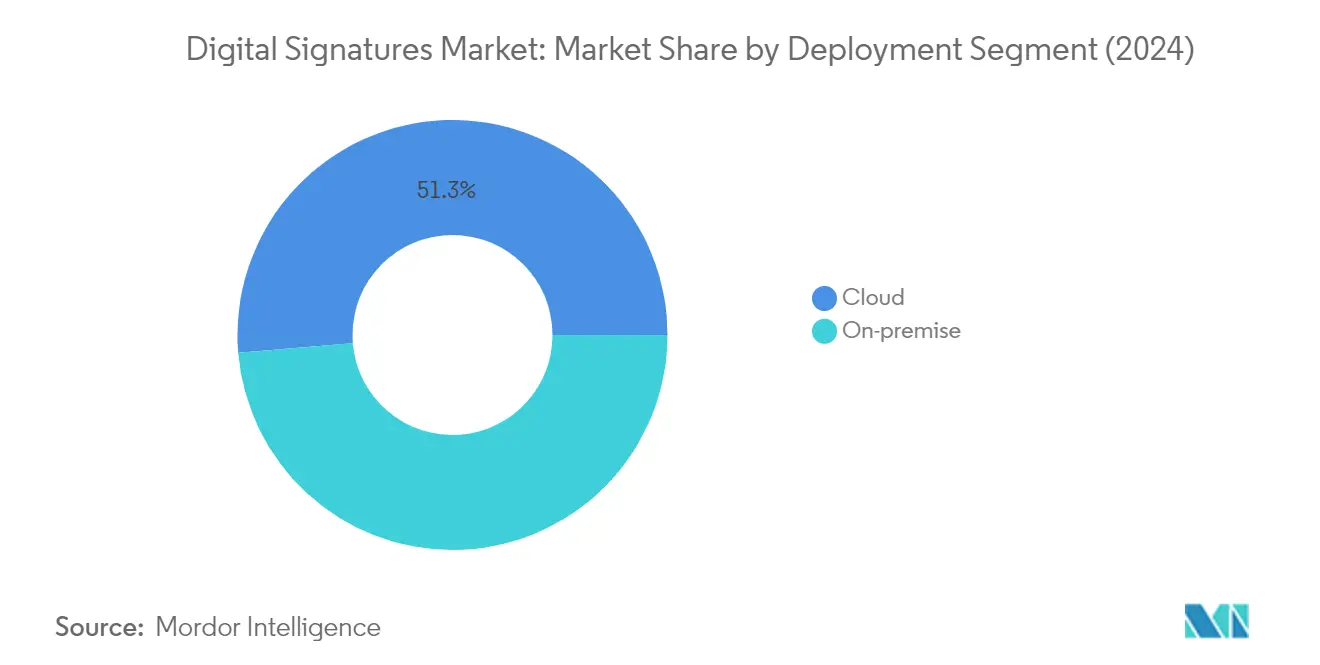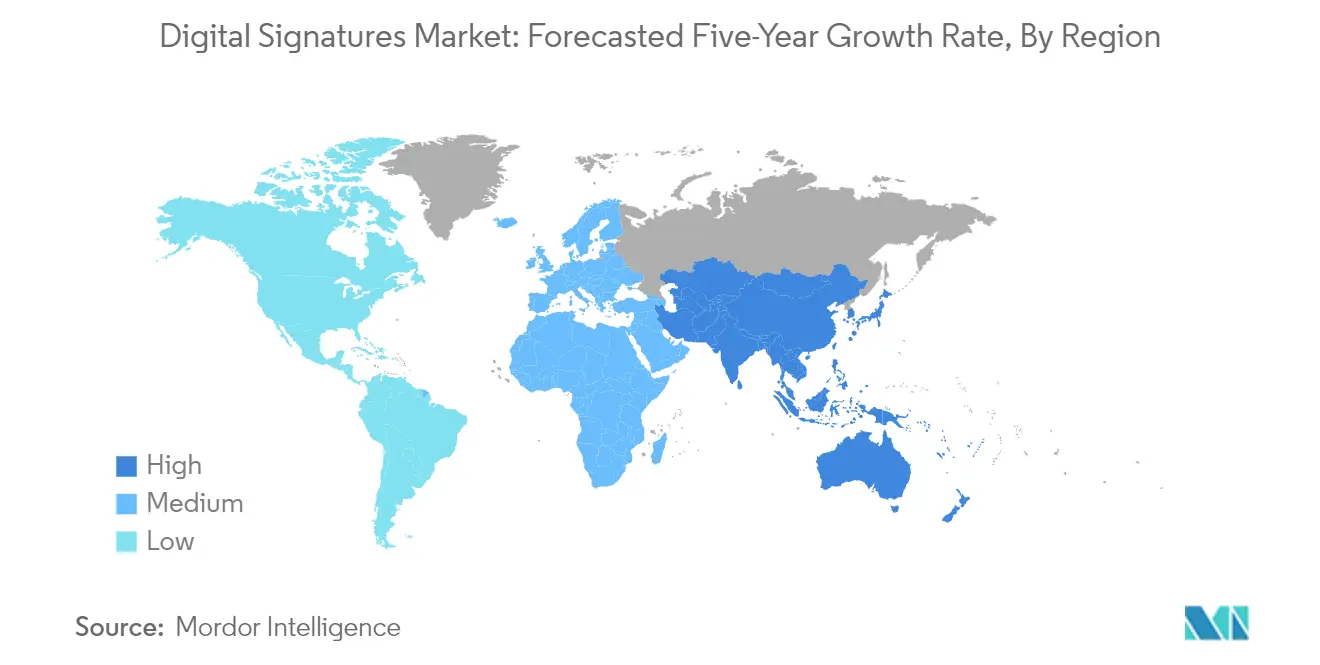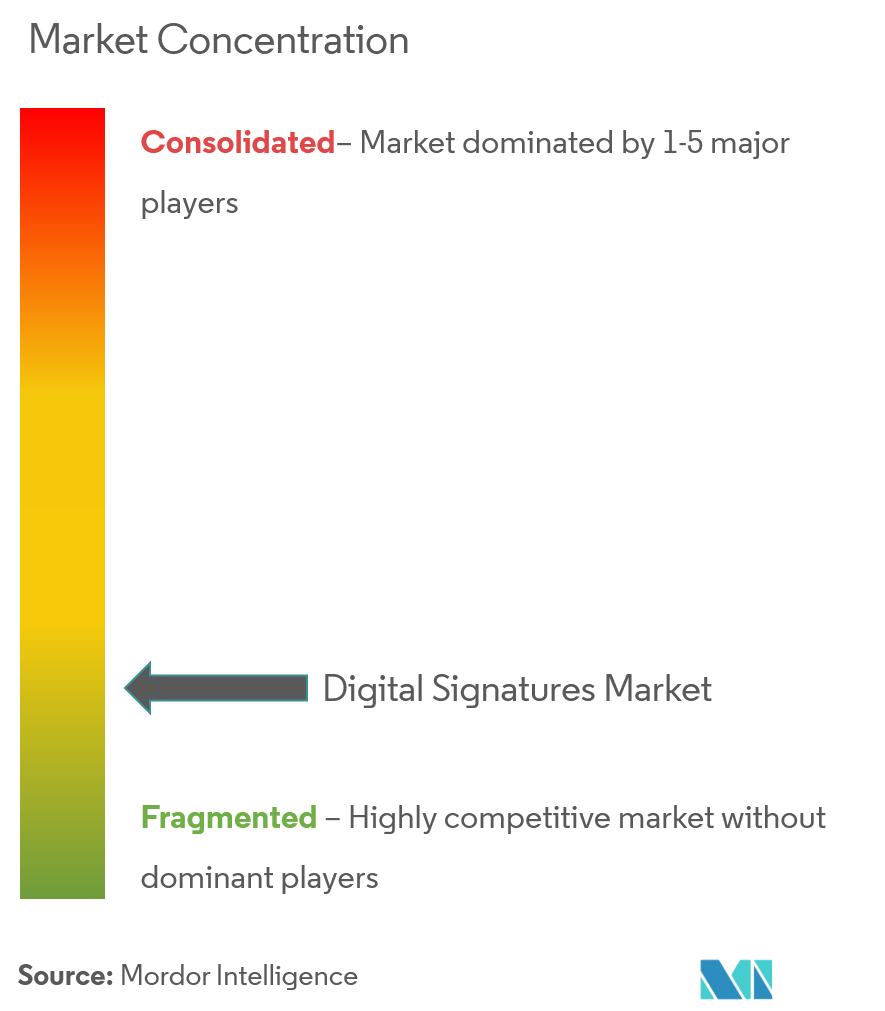
| Study Period | 2019 - 2030 |
| Market Size (2025) | USD 13.32 Billion |
| Market Size (2030) | USD 51.17 Billion |
| CAGR (2025 - 2030) | 30.88 % |
| Fastest Growing Market | Asia-Pacific |
| Largest Market | North America |
| Market Concentration | Low |
Major Players
*Disclaimer: Major Players sorted in no particular order |
Digital Signatures Market Analysis
The Digital Signatures Market size is estimated at USD 13.32 billion in 2025, and is expected to reach USD 51.17 billion by 2030, at a CAGR of 30.88% during the forecast period (2025-2030).
The digital signatures landscape is experiencing a fundamental transformation driven by the increasing digitalization of business processes and the growing emphasis on secure, paperless transactions. Financial institutions and banks are leading this transformation, with recent studies indicating that 52.20% of e-commerce payments are expected to be processed through digital wallets, necessitating robust digital signature infrastructure. This shift is particularly evident in the emergence of new digital banking platforms and financial technology solutions that integrate advanced signature verification systems. The integration of blockchain technology in digital signatures is gaining traction, enabling enhanced security features and immutable verification processes across various sectors.
The healthcare sector is emerging as a significant adopter of digital signature solutions, with recent industry surveys revealing that 52% of consumers express a favorable view of healthcare providers utilizing digital technology throughout their patient interactions. Major healthcare institutions are implementing comprehensive digital signature solutions for everything from patient onboarding to insurance documentation. The sector's digital transformation is further accelerated by the introduction of integrated electronic health record systems that require secure digital signing capabilities for maintaining regulatory compliance and ensuring patient data security.
Generational differences are significantly influencing the adoption patterns of digital signatures, with Adobe reporting that 73% of younger consumers prefer using smart devices for document signing compared to just 25% of Baby Boomers. This demographic shift is prompting organizations to develop more mobile-friendly signature solutions and intuitive user interfaces. Enterprise software providers are responding to this trend by introducing advanced mobile applications and cloud-based signing platforms that offer seamless integration with existing business workflows.
The market is witnessing substantial strategic activities, exemplified by significant mergers and acquisitions such as Box's acquisition of SignRequest for $55 million, highlighting the industry's consolidation trends. Strategic partnerships between major technology providers are reshaping the competitive landscape, as evidenced by the collaboration between Amazon Web Services and AirSlate's SignNow for enhanced electronic signature capabilities. These partnerships are fostering innovation in areas such as artificial intelligence-powered signature verification and automated document processing, while simultaneously addressing growing concerns about digital compliance and regulatory compliance.
Digital Signatures Market Trends
Rise in E-Signatures and Adoption of Cloud-Based Services
The increasing adoption of cloud signature solutions has become a fundamental driver for the digital signature market, as organizations seek more flexible and efficient ways to manage document workflows. Cloud-based digital signature solutions enable seamless integration across departments like sales, logistics, and human resources, allowing organizations to eliminate paperwork bottlenecks and streamline their operations. The technology's ability to facilitate remote document signing while maintaining security and compliance has made it particularly attractive for businesses looking to modernize their processes. According to the Worldpay Global Payments Report, digital wallet payments are expected to account for 52.20% of e-commerce transactions, highlighting the growing preference for digital solutions in transaction processing and verification.
The shift toward cloud-based digital signature services is further accelerated by their ability to provide enhanced accessibility and cost-effectiveness compared to traditional paper-based processes. Modern electronic signature solutions offer comprehensive features, including document tracking, automated workflows, and integration capabilities with existing business systems like CRM platforms and document management solutions. This integration capability has proven particularly valuable, as demonstrated by major platforms like Adobe, which has processed over 8 billion electronic signatures, showcasing the massive scale of adoption. The demographic shift in technology adoption is also evident, with Adobe reporting that 73% of younger consumers prefer using smart devices for signatures compared to just 25% of baby boomers, indicating a strong future growth trajectory for digital signature solutions.
The evolution of regulatory frameworks and government initiatives has provided additional momentum to cloud signature adoption. Various governments have implemented supportive legislation such as the Uniform Electronic Transactions Act (UETA) and the Electronic Signatures in Global and National Commerce Act (E-SIGN), which have established the legal validity of e-signatures for transactions. These regulations have been complemented by technological advancements in security measures, including blockchain integration, biometric authentication, and advanced encryption protocols, which have enhanced the trustworthiness and reliability of digital signature solutions. The combination of regulatory support and technological innovation has created a robust foundation for continued market expansion in the digital signature space, bolstered by digital compliance and public key infrastructure systems that ensure digital identity verification and electronic authentication. Furthermore, these advancements contribute to digital transaction security, reinforcing the reliability of these solutions.
Segment Analysis: By Deployment
Cloud Segment in Digital Signatures Market
The cloud signature segment has emerged as the dominant force in the digital signature market, commanding approximately 51% of the market share in 2024. This leadership position is driven by the increasing adoption of cloud-based solutions across various industries due to their scalability, cost-effectiveness, and ease of implementation. Organizations are increasingly preferring cloud-based digital signature solutions as they enable seamless remote work capabilities, facilitate cross-border transactions, and provide enhanced security features through advanced encryption protocols. The segment's growth is further accelerated by the rising demand for paperless workflows, the need for efficient document management systems, and the increasing focus on environmental sustainability. Cloud-based digital signature solutions also offer advantages such as automatic updates, reduced IT infrastructure costs, and improved collaboration capabilities, making them particularly attractive for businesses of all sizes. The segment is experiencing the fastest growth rate in the market with a projected growth rate of approximately 31% from 2024 to 2029, driven by continuous technological advancements, increasing digital transformation initiatives, and the growing acceptance of cloud solutions in highly regulated industries.

On-premise Segment in Digital Signatures Market
The on-premise segment continues to maintain a significant presence in the digital signature market, particularly among organizations with stringent data security requirements and regulatory compliance needs. This deployment model is preferred by enterprises in highly regulated industries such as banking, healthcare, and government sectors, where data sovereignty and complete control over the infrastructure are paramount. On-premise solutions offer organizations the ability to maintain their security protocols, customize the implementation according to specific requirements, and ensure compliance with industry-specific regulations. The segment's resilience is supported by organizations that prioritize data privacy, require offline functionality, or have existing infrastructure investments that favor on-premise deployments. Additionally, large enterprises with substantial IT resources and specific compliance requirements continue to opt for on-premise solutions to maintain direct control over their digital signature infrastructure and sensitive data.
Segment Analysis: By Offering
Software Segment in Digital Signatures Market
The software segment dominates the digital signature market, commanding approximately 37% market share in 2024. This significant market position is driven by the increasing adoption of digital signature software solutions across various industries, particularly in sectors like BFSI, healthcare, and government. Software solutions offer enhanced security features, including encryption capabilities, audit trails, and authentication mechanisms that ensure the integrity and legal validity of electronically signed documents. The segment's growth is further bolstered by the rising demand for cloud-based digital signature software that enables remote document signing and verification, making it particularly valuable for organizations embracing hybrid work models and digital transformation initiatives.
Service Segment in Digital Signatures Market
The service segment is emerging as the fastest-growing segment in the digital signature market, projected to grow at approximately 30% during 2024-2029. This remarkable growth is attributed to the increasing demand for implementation, integration, and maintenance services associated with digital signature solutions. Organizations are increasingly seeking professional services to ensure seamless deployment of digital signature platforms, compliance with regulatory requirements, and ongoing technical support. The growth is also driven by the rising need for customized digital signature solutions that cater to specific industry requirements and the growing complexity of digital workflows requiring expert consultation and managed services.
Remaining Segments in Digital Signatures Market
The hardware segment plays a crucial role in the digital signature market by providing the necessary physical infrastructure for secure digital signing processes. This includes signature capture devices, smart cards, USB tokens, and hardware security modules (HSMs) that enable secure key storage and signature generation. The segment's importance is particularly evident in industries requiring high-security standards and compliance with stringent regulations, such as government institutions and financial services. Hardware solutions continue to evolve with technological advancements, incorporating features like biometric authentication and enhanced security protocols to meet the growing demands for secure digital signing capabilities.
Segment Analysis: By End User
BFSI Segment in Digital Signatures Market
The Banking, Financial Services, and Insurance (BFSI) sector holds the dominant position in the digital signature market, accounting for approximately 19% market share in 2024. This leadership position is driven by the sector's increasing adoption of digital transformation initiatives and the growing need for secure electronic transactions. Financial institutions are leveraging electronic signature solutions for various applications, including account openings, loan agreements, investment documentation, wealth management, and mortgage agreements. The rise of digital banking and online financial services has further accelerated the adoption of digital signature in this sector. Additionally, younger consumers, particularly Gen Z and millennials, have emerged as a significant driving force behind the increased usage of digital signature in financial services, as they increasingly prefer digital methods for conducting financial transactions and signing documents.
Government Segment in Digital Signatures Market
The government sector is emerging as the fastest-growing segment in the digital signature market, with a projected growth rate of approximately 31% during 2024-2029. This rapid growth is attributed to increasing government initiatives for digital transformation and paperless operations across various administrative functions. Government agencies are increasingly adopting digital signature for various applications, including forms processing, document verification, citizen services, and administrative workflows. The implementation of digital certificate solutions helps government bodies improve access to critical data while simultaneously reducing costs associated with paper-based processes. The sector's growth is further supported by various digital governance initiatives and the increasing focus on providing efficient and transparent services to citizens through digital platforms.
Remaining Segments in Digital Signatures Market by End User
The digital signature market encompasses several other significant segments, including Healthcare, Oil and Gas, Military and Defense, Logistics and Transportation, Research and Education, and other end users. The healthcare sector utilizes electronic authentication for patient records, prescriptions, and regulatory compliance documentation. The military and defense sector employs these solutions for secure document workflows and classified information handling. Logistics and transportation companies leverage secure signature for shipping documents, delivery confirmations, and supply chain management. The research and education sector implements these solutions for academic documentation, administrative processes, and student records management. Each of these segments contributes uniquely to the market's growth by addressing specific industry requirements for secure and efficient document processing.
Digital Signatures Market Geography Segment Analysis
Digital Signatures Market in North America
North America represents a mature digital signature market, characterized by widespread adoption across various industries, including BFSI, healthcare, and government sectors. The region benefits from advanced technological infrastructure, supportive regulatory frameworks like the ESIGN Act, and high digital literacy rates. Both the United States and Canada have shown significant traction in adopting digital signature solutions, driven by the increasing need for secure remote transactions and paperless workflows. The presence of major digital signature vendors and continuous technological innovations has further strengthened the region's position in the global digital signature market.

Digital Signatures Market in United States
The United States leads the North American digital signature market with its robust technological ecosystem and widespread digital transformation initiatives across industries. The country's market is driven by strong regulatory support, increasing adoption in the healthcare sector, and a growing emphasis on secure digital transactions. The financial services sector has been particularly active in implementing digital signature solutions, while government agencies have been promoting their use for various administrative processes. The United States holds approximately 74% of the North American digital signature market share, reflecting its dominant position in the region.
Digital Signatures Market in Canada
Canada has emerged as a rapidly growing market for digital signatures, driven by progressive regulations and increasing digitalization across industries. The country's market is characterized by strong adoption in the banking sector, government initiatives, and growing awareness about secure digital transactions. Canadian businesses are increasingly embracing digital signature solutions to streamline their operations and enhance efficiency. The market is expected to grow at approximately 26% annually from 2024 to 2029, supported by favorable government policies and increasing digital transformation initiatives across various sectors.
Digital Signatures Market in Europe
The European digital signature market demonstrates strong growth potential, supported by the eIDAS regulation and increasing digital transformation initiatives across the region. Countries like Germany, France, and the United Kingdom are at the forefront of adoption, each bringing unique strengths to the market. The region benefits from strong regulatory frameworks, high digital literacy rates, and increasing awareness about secure digital transactions. The European market is characterized by a strong focus on compliance and security, making it a key battleground for digital signature vendors.
Digital Signatures Market in Germany
Germany stands as the largest market for digital signatures in Europe, driven by its robust industrial base and strong emphasis on digital transformation. The country's market is characterized by high adoption rates in the banking sector, manufacturing industry, and government services. German businesses have shown particular interest in advanced digital signature solutions that offer high security and compliance with EU regulations. The country holds approximately 15% of the European digital signature market share, establishing itself as a key player in the region.
Digital Signatures Market in France
France has emerged as one of the fastest-growing markets for digital signatures in Europe, driven by strong government support and increasing digitalization across industries. The country has shown significant progress in adopting digital signature solutions, particularly in the banking, insurance, and public sectors. French businesses are increasingly recognizing the importance of digital signatures in improving operational efficiency and customer experience. The market is expected to grow at approximately 27% annually from 2024 to 2029, supported by favorable government initiatives and increasing digital transformation efforts.
Digital Signatures Market in Asia-Pacific
The Asia-Pacific region represents a dynamic digital signature market, characterized by rapid digital transformation and increasing adoption across various sectors. Countries like China, Japan, and South Korea are leading the regional market with their advanced technological infrastructure and supportive government initiatives. The region demonstrates strong growth potential, driven by increasing internet penetration, a growing e-commerce sector, and rising awareness about secure digital transactions. The market is witnessing significant investments in digital infrastructure and an increasing focus on regulatory frameworks to support digital signature adoption.
Digital Signatures Market in China
China dominates the Asia-Pacific digital signature market, leveraging its vast digital ecosystem and strong emphasis on technological advancement. The country's market is driven by rapid digitalization in the banking sector, a growing e-commerce industry, and supportive government policies. Chinese businesses are increasingly adopting digital signature solutions to enhance operational efficiency and improve customer experience. The market benefits from the country's large user base and growing emphasis on secure digital transactions.
Digital Signatures Market in South Korea
South Korea has established itself as a rapidly growing market for digital signatures, supported by its advanced technological infrastructure and strong digital innovation culture. The country's market is characterized by high adoption rates in the banking sector, government services, and e-commerce industry. South Korean businesses are actively embracing digital signature solutions to streamline their operations and enhance security. The market benefits from supportive government policies and increasing awareness about secure digital transactions.
Digital Signatures Market in Latin America
The Latin American digital signature market is experiencing significant growth, with Brazil emerging as both the largest and fastest-growing market in the region. The market is characterized by increasing adoption of digital signature solutions across various sectors, particularly in banking, government, and e-commerce. Countries in the region are implementing supportive regulations and frameworks to facilitate the adoption of digital signatures. The market benefits from growing internet penetration, increasing awareness about secure digital transactions, and rising demand for paperless solutions. Regional businesses are increasingly recognizing the importance of digital signatures in improving operational efficiency and enhancing customer experience.
Digital Signatures Market in Middle East & Africa
The Middle East & Africa region presents significant growth opportunities in the digital signature market, driven by increasing digital transformation initiatives and growing awareness about secure digital transactions. The market is characterized by strong adoption in the banking sector, government services, and emerging digital businesses. Countries in the region are implementing supportive regulations and frameworks to facilitate the adoption of digital signatures. The United Arab Emirates leads the market in terms of size, while Saudi Arabia shows the fastest growth potential. The region benefits from increasing investments in digital infrastructure and rising demand for secure digital transaction solutions across various sectors.
Digital Signatures Industry Overview
Top Companies in Digital Signatures Market
The digital signature market features established technology leaders and specialized solution providers competing through continuous innovation and strategic expansion. Companies are focusing on developing comprehensive product portfolios that combine core electronic signature capabilities with advanced features like identity verification, workflow automation, and blockchain integration. Operational agility is demonstrated through the rapid deployment of cloud-based solutions and flexible deployment models, including on-premise and hybrid options. Strategic partnerships, particularly with cloud service providers and industry-specific solution vendors, have become crucial for expanding market reach. Geographic expansion is being pursued through both direct presence and partner networks, with a particular focus on high-growth regions in Asia-Pacific and emerging markets.
Consolidated Market Led By Global Players
The digital signature market exhibits moderate consolidation with a mix of global technology conglomerates and specialized e-signature solution providers dominating the landscape. Large technology companies leverage their existing enterprise relationships, comprehensive product ecosystems, and substantial R&D capabilities to maintain market leadership. Specialized providers compete through deep domain expertise, industry-specific solutions, and superior customer service. The market has witnessed significant merger and acquisition activity as larger players seek to acquire innovative technologies and expand their geographic presence.
The competitive dynamics are characterized by intense rivalry among established players while maintaining high barriers to entry for new participants. Market leaders are increasingly focusing on vertical-specific solutions, particularly in highly regulated industries like healthcare, financial services, and government. Regional players maintain strong positions in their home markets through local regulatory compliance expertise and established customer relationships. The ecosystem is further enriched by partnerships between technology providers, system integrators, and industry consultants who collaborate to deliver comprehensive digital transformation solutions.
Innovation and Customer Focus Drive Success
Success in the digital signature vendors market increasingly depends on the ability to deliver comprehensive solutions that address specific industry needs while ensuring seamless integration with existing enterprise systems. Incumbent providers must focus on continuous innovation in areas like artificial intelligence, blockchain, and advanced authentication methods while maintaining strict security and compliance standards. Building strong partner ecosystems, investing in customer success programs, and developing industry-specific expertise have become crucial for maintaining market leadership. The ability to provide flexible deployment options and scalable pricing models is essential for capturing opportunities across different customer segments.
Market contenders can gain ground by focusing on underserved segments and geographies while developing specialized solutions for specific use cases or industries. The increasing adoption of digital transformation initiatives across industries presents opportunities for providers who can effectively address integration challenges and regulatory requirements. Success factors include developing strong technology partnerships, maintaining agility in product development, and building robust customer support capabilities. The regulatory landscape continues to evolve, with compliance requirements becoming more stringent, making it essential for providers to maintain strong governance frameworks and adapt their solutions to meet changing requirements. Providers must also focus on digital compliance and digital authentication to ensure their solutions meet the evolving needs of the market.
Digital Signatures Market Leaders
-
DocuSign
-
HelloSign
-
SunGard Signix Inc.
-
SafeNet Inc.
-
ePadLink
- *Disclaimer: Major Players sorted in no particular order

Digital Signatures Market News
- October 2022: The Ministry of Digital Development, Innovations and Aerospace Industry and Foreign Investors' Council Association launched a pilot project utilizing international digital signatures to increase the efficiency of commercial transactions involving Kazakh and global companies.
- March 2022: Odyssey Tech launched Xorkeesign to help users digitally sign GST, and IT returns. Xorkeesign G2C is a browser extension that stays invisible until a user accesses the IT, GST, or Ministry of Corporate Affairs portals. It then helps users sign their returns with no additional tool requirement.
Digital Signatures Market Report - Table of Contents
1. INTRODUCTION
- 1.1 Study Assumptions and Market Definition
- 1.2 Scope of the Study
2. RESEARCH METHODOLOGY
3. EXECUTIVE SUMMARY
4. MARKET INSIGHTS
- 4.1 Market Overview
-
4.2 Industry Attractiveness - Porter's Five Forces Analysis
- 4.2.1 Bargaining Power of Suppliers
- 4.2.2 Bargaining Power of Buyers
- 4.2.3 Threat of New Entrants
- 4.2.4 Threat of Substitute Products
- 4.2.5 Intensity of Competitive Rivalry
- 4.3 Assessment of COVID-19 Impact on the Industry
5. MARKET DYNAMICS
-
5.1 Market Drivers
- 5.1.1 Rise in E-signatures and Adoption of Cloud-based Services
- 5.1.2 Increse in Remote Work Culture and Overseas Contracts
-
5.2 Market Restraints
- 5.2.1 Increasing Vulnerability Related to Cyber Attacks and Frauds
6. MARKET SEGMENTATION
-
6.1 By Deployment
- 6.1.1 On-premise
- 6.1.2 Cloud
-
6.2 By Offering
- 6.2.1 Software
- 6.2.2 Hardware
- 6.2.3 Service
-
6.3 By End-user Industry
- 6.3.1 BFSI
- 6.3.2 Government
- 6.3.3 Healthcare
- 6.3.4 Oil and Gas
- 6.3.5 Military and Defense
- 6.3.6 Logistics and Transportation
- 6.3.7 Research and Education
- 6.3.8 Other End-user Industries (Real Estate, Manufacturing, Legal, IT, and Telecom)
-
6.4 By Geography
- 6.4.1 North America
- 6.4.1.1 United States
- 6.4.1.2 Canada
- 6.4.2 Europe
- 6.4.2.1 United Kingdom
- 6.4.2.2 Germany
- 6.4.2.3 France
- 6.4.2.4 Rest of Europe
- 6.4.3 Asia-Pacific
- 6.4.3.1 China
- 6.4.3.2 Japan
- 6.4.3.3 South Korea
- 6.4.3.4 Rest of Asia-Pacific
- 6.4.4 Rest of the World
- 6.4.4.1 Latin America
- 6.4.4.2 Middle East and Africa
7. COMPETITIVE LANDSCAPE
-
7.1 Company Profiles
- 7.1.1 SunGard Signix Inc.
- 7.1.2 DocuSign
- 7.1.3 Silanis-eSignLive
- 7.1.4 SafeNet Inc.
- 7.1.5 ePadLink
- 7.1.6 Topaz systems
- 7.1.7 Ascertia
- 7.1.8 DigiStamp Inc.
- 7.1.9 GMO GlobalSign Inc.
- 7.1.10 RightSignature
- 7.1.11 HelloSign
- 7.1.12 Wacom
- 7.1.13 Adobe Sign
- 7.1.14 airSlate Inc.
- 7.1.15 PandaDoc Inc.
- 7.1.16 SignEasy
- *List Not Exhaustive
8. INVESTMENT ANALYSIS
9. FUTURE OF THE MARKET
Digital Signatures Industry Segmentation
Digital signatures are the most advanced and secure type of electronic signature. One can use them to comply with the most demanding legal and regulatory requirements because they provide the highest levels of assurance about each signer's identity and the authenticity of the documents they sign. It has applications in government, judicial, telecom, e-commerce, and BFSI. The study under consideration covers hardware, software, and service offerings. The study also analyses different deployment modes of digital signatures, such as on-premise and cloud platforms.
The digital signatures market can be segmented by deployment (on-premise and cloud), offering (software, hardware, and service), end-user industry (BFSI, government, healthcare, oil and gas, military and defense, logistics and transportation, research and education, and other end-user industries (real estate, manufacturing, legal, IT, and telecom), and geography (North America, Europe, Asia-Pacific, and the rest of the world).
The market sizes and forecasts are provided in terms of value (USD billion) for all the above segments.
| By Deployment | On-premise | ||
| Cloud | |||
| By Offering | Software | ||
| Hardware | |||
| Service | |||
| By End-user Industry | BFSI | ||
| Government | |||
| Healthcare | |||
| Oil and Gas | |||
| Military and Defense | |||
| Logistics and Transportation | |||
| Research and Education | |||
| Other End-user Industries (Real Estate, Manufacturing, Legal, IT, and Telecom) | |||
| By Geography | North America | United States | |
| Canada | |||
| Europe | United Kingdom | ||
| Germany | |||
| France | |||
| Rest of Europe | |||
| Asia-Pacific | China | ||
| Japan | |||
| South Korea | |||
| Rest of Asia-Pacific | |||
| Rest of the World | Latin America | ||
| Middle East and Africa | |||
Digital Signatures Market Research FAQs
How big is the Digital Signatures Market?
The Digital Signatures Market size is expected to reach USD 13.32 billion in 2025 and grow at a CAGR of 30.88% to reach USD 51.17 billion by 2030.
What is the current Digital Signatures Market size?
In 2025, the Digital Signatures Market size is expected to reach USD 13.32 billion.
Who are the key players in Digital Signatures Market?
DocuSign, HelloSign, SunGard Signix Inc., SafeNet Inc. and ePadLink are the major companies operating in the Digital Signatures Market.
Which is the fastest growing region in Digital Signatures Market?
Asia-Pacific is estimated to grow at the highest CAGR over the forecast period (2025-2030).
Which region has the biggest share in Digital Signatures Market?
In 2025, the North America accounts for the largest market share in Digital Signatures Market.
What years does this Digital Signatures Market cover, and what was the market size in 2024?
In 2024, the Digital Signatures Market size was estimated at USD 9.21 billion. The report covers the Digital Signatures Market historical market size for years: 2019, 2020, 2021, 2022, 2023 and 2024. The report also forecasts the Digital Signatures Market size for years: 2025, 2026, 2027, 2028, 2029 and 2030.
Our Best Selling Reports
Digital Signatures Market Research
Mordor Intelligence provides a comprehensive analysis of the digital signature and electronic signature industry. We leverage our extensive expertise in digital identity research and consulting. Our detailed report examines the evolution of PKI (public key infrastructure) solutions, digital certificate implementations, and document authentication methodologies. This analysis covers qualified electronic signature technologies, cloud signature innovations, and emerging digital compliance frameworks. It offers deep insights into cryptographic signature protocols and advanced electronic signature solutions.
Stakeholders benefit from our thorough examination of electronic document signing trends, digital authentication processes, and secure signature technologies. The report explores remote signing capabilities, digital validation methods, and paperless signing solutions. It also analyzes developments in digital transaction security. Our research covers electronic authentication systems and digital identity verification frameworks. This information is available in an easy-to-download report PDF format. The comprehensive analysis includes detailed insights into PKI industry dynamics and emerging esign solution providers. It offers valuable intelligence for strategic decision-making in the digital transformation landscape.




